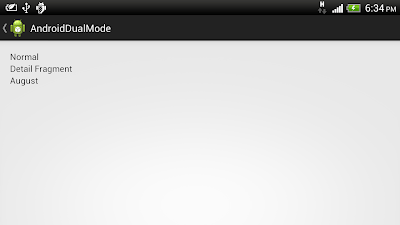Alternatively, we can implements OnBackStackChangedListener, add it in FragmentManager by calling addOnBackStackChangedListener(), and override onBackStackChanged() method to check emptiness of back stack entry by calling getBackStackEntryCount(), then call setDisplayHomeAsUpEnabled() accordingly.
package com.example.androiddualmode;
import android.os.Bundle;
import android.app.Activity;
import android.app.Fragment;
import android.app.FragmentManager.OnBackStackChangedListener;
import android.app.FragmentTransaction;
import android.app.ListFragment;
import android.view.LayoutInflater;
import android.view.MenuItem;
import android.view.View;
import android.view.ViewGroup;
import android.widget.ArrayAdapter;
import android.widget.ListAdapter;
import android.widget.ListView;
import android.widget.TextView;
public class MainActivity extends Activity implements OnBackStackChangedListener{
// if run on phone, isSinglePane = true
// if run on tablet, isSinglePane = false
static boolean isSinglePane;
static String[] month ={
"January", "February", "March", "April",
"May", "June", "July", "August",
"September", "October", "November", "December"};
public static class MyListFragment extends ListFragment {
@Override
public void onActivityCreated(Bundle savedInstanceState) {
// TODO Auto-generated method stub
super.onActivityCreated(savedInstanceState);
ListAdapter myArrayAdapter =
new ArrayAdapter<String>(
getActivity(), android.R.layout.simple_list_item_1, month);
setListAdapter(myArrayAdapter);
}
@Override
public void onListItemClick(ListView l, View v, int position, long id) {
String clickedDetail = (String)l.getItemAtPosition(position);
if(isSinglePane == true){
/*
* The second fragment not yet loaded.
* Load MyDetailFragment by FragmentTransaction, and pass
* data from current fragment to second fragment via bundle.
*/
MyDetailFragment myDetailFragment = new MyDetailFragment();
Bundle bundle = new Bundle();
bundle.putString("KEY_DETAIL", clickedDetail);
myDetailFragment.setArguments(bundle);
FragmentTransaction fragmentTransaction =
getActivity().getFragmentManager().beginTransaction();
fragmentTransaction.replace(R.id.phone_container, myDetailFragment);
/*
* Add this transaction to the back stack.
* This means that the transaction will be remembered after it is
* committed, and will reverse its operation when later popped off
* the stack.
*/
fragmentTransaction.addToBackStack(null);
fragmentTransaction.commit();
//getActivity().getActionBar().setDisplayHomeAsUpEnabled(true);
}else{
/*
* Activity have two fragments. Pass data between fragments
* via reference to fragment
*/
//get reference to MyDetailFragment
MyDetailFragment myDetailFragment =
(MyDetailFragment)getFragmentManager().findFragmentById(R.id.detail_fragment);
myDetailFragment.updateDetail(clickedDetail);
}
}
}
public static class MyDetailFragment extends Fragment {
TextView textDetail;
@Override
public View onCreateView(LayoutInflater inflater, ViewGroup container,
Bundle savedInstanceState) {
// TODO Auto-generated method stub
View view = inflater.inflate(R.layout.layout_detailfragment, null);
textDetail = (TextView)view.findViewById(R.id.text_detail);
Bundle bundle = getArguments();
if(bundle != null){
String detail = bundle.getString("KEY_DETAIL", "no argument pass");
textDetail.setText(detail);
}
return view;
}
public void updateDetail(String detail) {
textDetail.setText(detail);
}
}
@Override
protected void onCreate(Bundle savedInstanceState) {
super.onCreate(savedInstanceState);
setContentView(R.layout.activity_main);
View v = findViewById(R.id.phone_container);
if(v == null){
//it's run on tablet
isSinglePane = false;
/*
* MyListFragment and MyDetailFragment have been loaded in XML,
* no need load.
*/
}else{
//it's run on phone
//Load MyListFragment programmatically
isSinglePane = true;
if(savedInstanceState == null){
//if's the first time created
MyListFragment myListFragment = new MyListFragment();
FragmentTransaction fragmentTransaction = getFragmentManager().beginTransaction();
fragmentTransaction.add(R.id.phone_container, myListFragment);
fragmentTransaction.commit();
}
}
getFragmentManager().addOnBackStackChangedListener(this);
}
@Override
public boolean onOptionsItemSelected(MenuItem item) {
switch (item.getItemId()) {
case android.R.id.home:
getFragmentManager().popBackStack();
//getActionBar().setDisplayHomeAsUpEnabled(false);
return true;
}
return super.onOptionsItemSelected(item);
}
final static String KEY_DISPLAY_OPT = "KEY_Display_Option";
@Override
protected void onSaveInstanceState(Bundle outState) {
// TODO Auto-generated method stub
super.onSaveInstanceState(outState);
outState.putInt(KEY_DISPLAY_OPT, getActionBar().getDisplayOptions());
}
@Override
protected void onRestoreInstanceState(Bundle savedInstanceState) {
// TODO Auto-generated method stub
super.onRestoreInstanceState(savedInstanceState);
int savedDisplayOpt = savedInstanceState.getInt(KEY_DISPLAY_OPT);
if(savedDisplayOpt != 0){
getActionBar().setDisplayOptions(savedDisplayOpt);
}
}
@Override
public void onBackStackChanged() {
int backStackEntryCount = getFragmentManager().getBackStackEntryCount();
if(backStackEntryCount > 0){
getActionBar().setDisplayHomeAsUpEnabled(true);
}else{
getActionBar().setDisplayHomeAsUpEnabled(false);
}
}
}
Next:
- Implement animation in FragmentTransaction
